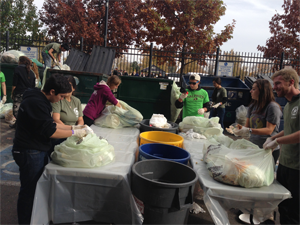Shining light on sustainability at the holidays – and beyond
“Doing what you can with what you have” may not be a common holiday theme, but it is something that staff and volunteers at the Environmental Center at CU-Boulder especially promote during this time of year when commercialism runs rampant.
Those colorful lights you string up in trees and around your house need lots of energy to produce that holiday glow – more than 2.2 million MWh of electricity, or enough to provide energy to more than 173,000 homes for one year.
Students sort through compost materials at Buffaloes football games, part of the CU-Boulder Environmental Center’s zero-waste initiative.
Americans produce 25 percent more trash this time of the year, notes the center, and much of that comes from wrapping paper torn from all those gifts. According to the center, if every family wrapped three presents in re-used materials, it would save enough paper to cover 45,000 football fields.
While one of the center’s goals is to educate the community, a larger mission is to promote a culture of sustainability at CU-Boulder through a variety of programs with the help of permanent staff, 120 student employees and 400-plus student and community volunteers. The most visible push from the center, which was founded in 1970, might be the zero-waste initiative at Buffs football and basketball games, where nearly all packaging and other items are reused, recycled or composted. Campus officials hope to reach their goal of 90 percent effectiveness by 2020.
Another center program provides home energy audits for students to help them understand the implications of energy use to both the environment and their pocketbooks, says SarahDawn Haynes, the center’s outreach and engagement coordinator. The center also provides bus pass and bicycle programs to reduce the carbon footprint.
Student employees also clean and repair used computers that are then given to high school students through a program that not only reduces waste but also supports the university’s mission to provide teens with the tools they need for educational success.
The center promotes environmental leadership and justice, says Haynes. “Recycling and investment in renewable energy is not just about people who afford it; it’s for everyone. Research shows that landfills are located primarily in low-income communities and those of color.”
Beyond the holidays, there are simple ways to create a culture of sustainability beyond recycling, monitoring energy use and reuse, Haynes says. Ideas include: buy locally whenever possible; stay informed about energy issues; encourage family and friends to be environmentally friendly; walk or bike instead of driving; and don’t buy packaged water.
“It’s critical to use what you have where you are at,” Haynes says. “All of these things add up to a better lifestyle for us and the world.”
HOLIDAY SUSTAINABILITY TIPS
(From the Environmental Center and Eco-Cycle)
- Wrapping paper is often used once and thrown away. Try using colorful pages torn from magazines to wrap small gifts, and old maps or the Sunday comics for larger boxes. Avoid using paper entirely by using reusable decorative tins, baskets or boxes. If you do buy wrapping paper, look for ones made of recycled paper. Reusable cloth ribbons can be used in place of plastic bows. Finally, unwrap gifts carefully and save wrappings for reuse next year.
- If you buy gifts, look for durable and reusable items and resist the latest “fad” at the mall. Think of how many pet rocks, mood rings and Cabbage Patch Dolls ended up in the landfill!
- Look for gifts with an environmental message: a nature book, a refillable thermos bottle, a canvas tote bag, a battery recharger or items made from recycled materials. Choose solar-powered instead of battery-powered products. Or better yet, ones that require no power at all.
- Other environmentally smart gifts include homemade ones: home-baked cookies, bread or jams, a plant or tree. Ones that don't create any waste at all: concert or movie tickets, dinner at a restaurant, or an IOU to help rake leaves or repair a leaky faucet. Ones that get “used up”: candles, soap, or seeds for next year's garden.
- If you go out shopping, bring your own tote bags and avoid coming home with an armload of plastic bags holding just one item.
- You are probably receiving piles of mail order catalogs at this time of year. Call the company's toll-free number and ask that you be removed from their mailing list. Fortunately, magazines and catalogs can be recycled on campus and at local recycling centers.
- If you send holiday cards, look for ones made of recycled paper. Avoid cards with glossy, shiny or gold foil coatings since these cannot be recycled. Save the cards that you get in the mail, cut off the front pictures, and reuse as “postcards” next year. This saves on postage too. Or, send '”electronic cards'” or make a phone call instead!
- For tree trimmings, try edible or compostable items like popcorn or cranberries on a string, gingerbread cookies or items made from "found" objects around your home.
- Use LED holiday lights, which last up to 10 times longer and use 80 percent less energy than traditional lights. When possible, use decorations powered by solar lights.



